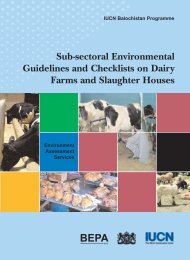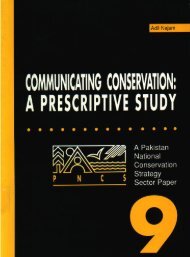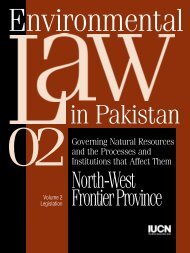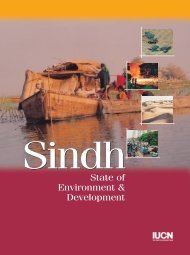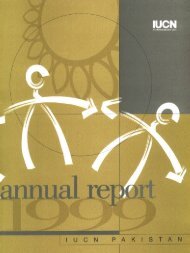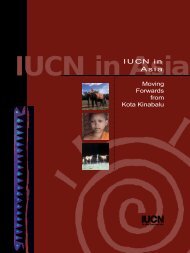Sustainable Fisheries - Pakistan Water Gateway
Sustainable Fisheries - Pakistan Water Gateway
Sustainable Fisheries - Pakistan Water Gateway
Create successful ePaper yourself
Turn your PDF publications into a flip-book with our unique Google optimized e-Paper software.
total inland fish production should be about<br />
125,000 tonnes. Marine fish landing will register<br />
a yearly increase of 70,000 tonnes thereby<br />
bringing the production figure to 400,000<br />
tonnes. This forecast, however, is based on the<br />
assumption that no conservatory charges or<br />
rational increases in developmental programmes,<br />
other than what is being practised<br />
today, occur.<br />
HABITAT DEGRADATION<br />
Inland Fishery<br />
Irrigation System<br />
Prior to the Indus Basin Development Project<br />
(IBDP) most fish came from existing reservoirs<br />
connected to the headworks of the irrigation system,<br />
while the Indus and its tributaries supported,<br />
largely, subsistence fishery. With the implementation<br />
of the IBDP, however, some drastic<br />
changes in habitat have taken place. This is<br />
because the project has regulated the flow of the<br />
river at various places for the creation of the<br />
Mangla and Tarbela dams. With the implementation<br />
of the project, forest cover has decreased<br />
in many places with a loss of catchment area,<br />
land that was a source of regular nutrient flow<br />
into the riverine system. There has also been a<br />
major shift in the type of fishery, i.e, from riverine<br />
to reservoir.<br />
Dams have also been set up on small<br />
streams and in the intermediate or dry zones<br />
which receive a substantial volume of rain during<br />
the monsoon season, but remain dry for the<br />
greater part of the year. These small and minidams<br />
have been built at a far more rapid rate<br />
than large dams. This has resulted in a gradual<br />
increase in area under cultivation, and the<br />
rehabilitation of old and introduction of new<br />
irrigation facilities. The development of new<br />
land for cultivation has been at the expense of<br />
the natural habitat and its associated fauna<br />
and flora, and particularly the flood-plain fish<br />
population. Habitat degradation together with<br />
the changing attitude of people (with regard to<br />
fish as food) has provided a challenge to planners<br />
and managers in this sector.<br />
The creation of the world’s largest canal irrigation<br />
system, which is now more than a century<br />
old, must have had a short-term effect on inland<br />
fishery but there is no record of this. However,<br />
the long-term effect has begun to become<br />
apparent. One outcome is the tremendous loss<br />
of agricultural land, estimated at about 5.5 million<br />
acres, to waterlogging.<br />
While the waterlogged areas are a threat to<br />
the country’s agriculture sector, they do have a<br />
hidden potential: they can be used for aquaculture.<br />
Careful planning is needed to check the<br />
rapid rate of waterlogging, at one end, and for<br />
its judicious use for productive fish farming, at<br />
the other.<br />
Erosion<br />
Sedimentation in reservoirs is attributed to soil<br />
erosion caused by deforestation in the catchment<br />
areas. This is particularly serious in the<br />
case of Tarbela Dam, where the sedimentation<br />
rate is so high that some reservoir capacity has<br />
already been lost. Sedimentation has also affected<br />
the productivity of the benthic fauna, which<br />
serves as food for fish and constitutes an important<br />
link in the food chain. This is occurring in<br />
other reservoirs also, but at different rates. The<br />
threat it poses to inland fisheries needs to be<br />
assessed to find a timely solution.<br />
Pollution<br />
Chemical Pollution<br />
Insecticides commonly used in agriculture are<br />
toxic to fish. However, toxicity varies with the<br />
chemical and its effect is either aggravated or<br />
lessened under various environmental conditions.<br />
Wastes from the Kala Shah Kaku industrial estate<br />
near Lahore have wiped out the fauna and flora<br />
of the water body into which the effluents are<br />
dumped, before it outfalls into the river Ravi.<br />
Organic Pollution<br />
Although organic pollution is generally useful for<br />
fish and aquaculture, if low oxygen or anaerobic<br />
conditions occur, it can arrest fish growth or<br />
cause mortalities.<br />
NCS SECTOR PAPER 9




